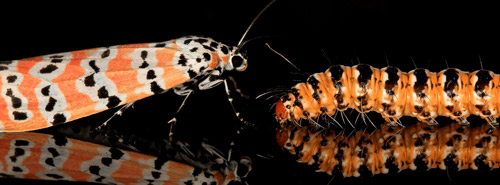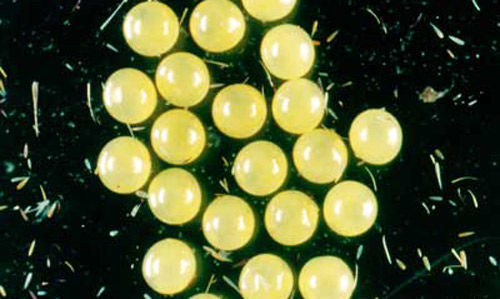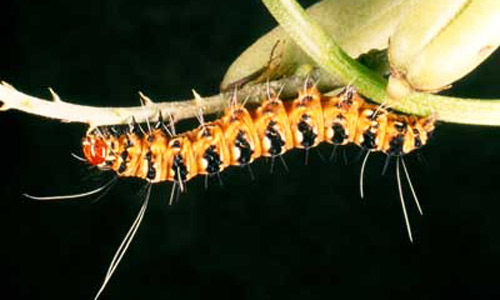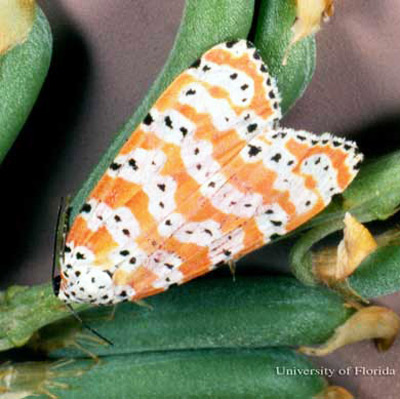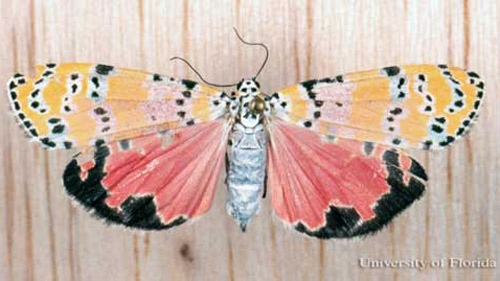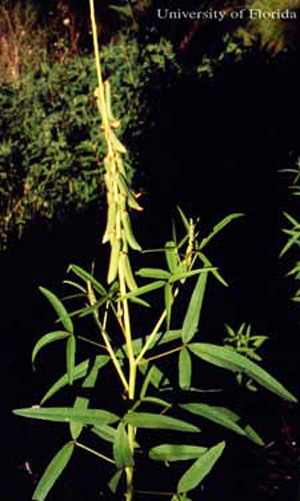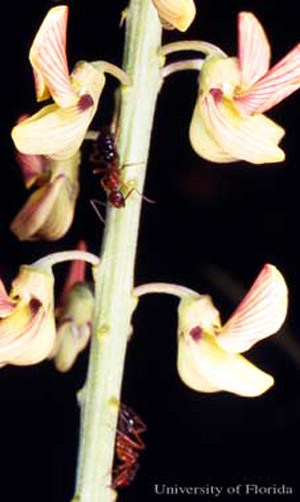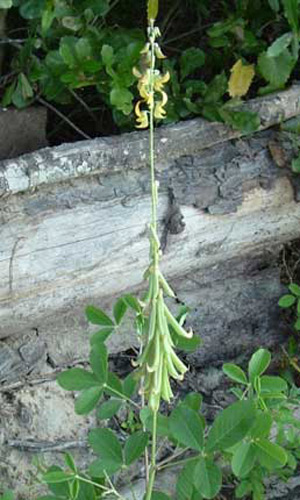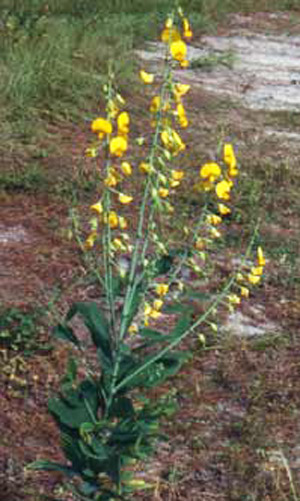common name: ornate bella moth, rattlebox moth
scientific name: Utetheisa ornatrix (Linnaeus) (Insecta: Lepidoptera: Erebidae: Arctiinae)
Introduction - Synonymy - Distribution - Description - Life Cycle and Biology - Hosts - Natural Enemies - Selected References
Introduction (Back to Top)
The ornate bella moth, Utetheisa ornatrix (Linnaeus), is one of our most beautiful moths (Figure 1). Unlike most moths, which are nocturnal, the ornate bella moth is diurnal and flies readily when disturbed. Therefore, it is more commonly seen than nocturnal species of moths by the public.
Figure 1. Adult and larva of the ornate bella moth, Utetheisa ornatrix (Linnaeus). Photograph by Lary Reeves, Entomology and Nematology Department, University of Florida.
Synonymy (Back to Top)
The adult ornate bella moth is highly variable in coloration which has resulted in confusion regarding its taxonomy and the assignment of many names to the numerous color "forms". Linnaeus (Linnei 1758) originally described two species in the genus Phalaena — ornatrix (more whitish or pale specimens) and bella (brightly colored specimens), and Hübner later moved them to the genus Utetheisa. Forbes (1960) included both forms under the species Utetheisa ornatrix.
Distribution (Back to Top)
The ornate bella moth is found from Connecticut westward to southeastern Nebraska, and southward to New Mexico, southeastern Arizona and Florida (Covell 2005, Powell & Opler 2009, North American Moth Photographers Group Undated). It is also found through Mexico and southward through Central (Powell & Opler 2009) and South America all the way to Argentina (Pease 1968) and throughout most of the Antilles (North American Moth Photographers Group Undated). In the U.S., it is more common in the southern part of its range.
Description (Back to Top)
Eggs: The eggs are white to yellow and spherical (Figure 2).
Figure 2. Eggs of the ornate bella moth, Utetheisa ornatrix (Linnaeus). Photograph by Don Hall, Entomology and Nematology Department, University of Florida.
Larvae: The larvae are orange-brown with broad irregular black bands on each segment (Figure 3). Full-grown larvae are 30-35 mm in length. There are distinct white spots on the anterior and posterior margins of the black bands. Whereas most arctiine larvae have verrucae (elevated wart-like areas on the cuticle) bearing many setae, Utetheisa larvae lack verrucae, and setae occur singly (Habeck 1987).
Figure 3. Larva of the ornate bella moth, Utetheisa ornatrix (Linnaeus). Photograph by Don Hall, Entomology and Nematology Department, University of Florida.
Pupae: The pupae are black with irregular orange-brown bands and are covered with a loose layer of silk (Figure 4).
Figure 4. Pupa of the ornate bella moth, Utetheisa ornatrix (Linnaeus). Photograph by Don Hall, Entomology and Nematology Department, University of Florida.
Adults: The adult ornate bella moth is a rather small moth (wingspan 3.0 to 4.5 cm). The more common "bella" form has the front wings yellow with white bands each containing a row of black dots, and the hindwings bright pink with an irregular marginal black band (Figures 5 and 6). The paler form originally designated "ornatrix" is restricted to southern Florida and southern Texas.
Figure 5. Adult ornate bella moth, Utetheisa ornatrix (Linnaeus), on fruit of lanceleaf rattlebox, Crotalaria lanceolata E. Mey. Photograph by Don Hall, Entomology and Nematology Department, University of Florida.
Figure 6. Adult ornate bella moth, Utetheisa ornatrix (Linnaeus). with wings spread. Photograph by Don Hall, Entomology and Nematology Department, University of Florida.
Life Cycle and Biology (Back to Top)
The ornate bella moth has two generations northward but may breed continuously in the southernmost parts of its range (Covell 2005). Eggs are laid in clusters on the foliage. Upon hatching, the young larvae feed on the foliage. In laboratory studies, young larvae fed on foliage of native species of Crotalaria developed faster than those fed on foliage of exotic species (Sourakov 2015). After feeding briefly on foliage, the larvae move to the unripe pods which they bore into to feed on the seeds Upon reaching maturity, larvae migrate from the host plant to pupate in sheltered situations under loose bark on nearby trees, in thick vegetation, or in debris.
Much of what we know about the biology of the ornate bella moth is due to the fascinating work of Thomas Eisner and his colleagues and graduate students. This work is summarized in his book, For Love of Insects (Eisner 2003, Chapter 10). The biology of the ornate bella moth is intricately intertwined with its Crotalaria host plants. Crotalaria plants (particularly the immature seeds) are laced with pyrrolizidine alkaloids. Immature seeds contain approximately five times the amount of pyrrolizidine alkaloid as the foliage (Ferro et al. 2006). Ornate bella moth larvae sequester these chemicals and become poisonous (and usually repellent) to predators. The alkaloids are retained in the pupal and adult stages and are ultimately passed on to the eggs.
Adults are concentrated in patches of Crotalaria. Males become active approximately 1 to 1½ hours after sunset and are attracted to females by a pulsed (Connor et al. 1980) sex attractant pheromone - composed primarily of the 21 carbon triene (3 double bonds) chemical Z,Z,Z-3,6,9-heneicosatriene originating from glands at the tip of the female's abdomen. The pheromone also contains diene and tetraene forms (two and four double bonds, respectively) (Connor et al. 1980, Jain et al. 1983). (For chemical structures of Utetheisa ornatrix pheromones, see El-Sayed (2014).
Males convert some of their Crotalaria alkaloids to a related compound hydroxydanaidal (HD), and upon approaching a female, expose two eversible brushes (coremata) from the tip of the abdomen that contain HD saturated scales (Conner et al. 1981, Connor et al. 1990). Fanning the female with the coremata stimulates her to raise her wings exposing her abdomen. The male then lands beside her and copulates. In addition to sperm, males also transfer nutrients and HD to the female during mating via the spermatophore. The concentration of HD in the coremata is correlated with the amount of alkaloid carried by the males. Females measure the HD concentration of males and use that information for selecting males with the potential to donate the most pyrrolizidine alkaloids in the spermatophore (Conner et al. 1981, Dussourd et al. 1991, Iyengar et al. 2001). Higher HD alkaloid levels in males is correlated with larger body size which is a heritable trait (Iyengar & Eisner 1999a&b). Therefore, by selecting males with higher gifts of HD alkaloid, females are simultaneously selecting for increased male body size – a trait that will be passed on to her progeny. Furthermore, females are able to control which sperm fertilize the eggs, and those from larger males are more likely to fertilize the eggs (Egan et al. 2016, LaMunyon & Eisner 1993). The mechanism by which females control the flow of sperm is unknown, but LaMunyon & Eisner (1993) hypothesized that females make the decision based on the degree of distension of the bursa copulatrix (insect vagina) by each spermatophore. The larger spermatophores of larger males would cause greater distension of the bursa.
Adult ornate bella moths live approximately three weeks and females mate on average four to five times and as many as 13 times — each time receiving additional nutrients and alkaloids as nuptial gifts via the spermatophores. The additional nutrients allow the female to lay a larger number of eggs than would otherwise be possible. During oviposition, the female contributes not only her own alkaloids, but also those received from the male to her eggs making the eggs even more toxic to potential predators. Bezzerides and Eisner (2002) have demonstrated that individual eggs from multiply-mated females receive alkaloids from more than one male. The female herself also gains additional protection from predators due to the additional alkaloids from the male spermatophores (González et al. 1999).
Because most of our common Crotalarias are introduced weedy species and toxic to cattle, the ornate bella moth plays a beneficial role by eating their seeds and suppressing their reproduction.
Hosts (Back to Top)
Although a variety of plants in the family Fabaceae are listed in the literature as hosts for the ornate bella moth (Covell 2005, Robinson et al. 2010, Tietz 1972), species in the genus Crotalaria (e.g., Figures 7 to 10) are without a doubt the major if not the only true hosts. It is possible that the other host records are due to the habit of full-grown larvae to wander from the host plant (and often onto other species) prior to pupation.
Only four species of Crotalaria are native to the southeastern U.S. of which two occur in Florida — Avon Park rattlebox (Crotalaria avonensis DeLaney & Wunderlin), which is restricted to Florida, and rabbitbells (Crotalaria rotundifolia J.F. Gmel.). Many other species of Crotalaria were introduced into the southeastern U.S. 55-65 years ago for soil improvement and forage. Unfortunately, species of Crotalaria are toxic to livestock due to the presence of pyrrolizidine alkaloids, and are potentially fatal. Three species of Crotalaria have become established and are common in Florida. These are Crotalaria lanceolata E. Mey. and Crotalaria pallida Aiton var. obovata (G. Don) Pohill (formerly Crotalaria mucronata Desv.) which are both native to Africa and Crotalaria spectabilis Roth which is native to Asia. The name Crotalaria originates from the Greek root "crotal" which means "a rattle". It is the same root word as used in the genus name for rattle snakes, Crotalus. The mature dried fruit of Crotalaria rattles like a rattle snake when the pods are shaken or blown by the wind.
Figure 7. Lanceleaf rattlebox, Crotalaria lanceolata E. Mey, in fruit. This plant is a host of the ornate bella moth, Utetheisa ornatrix (Linnaeus). Photograph by Don Hall, Entomology and Nematology Department, University of Florida.
Figure 8. A flower spike of lanceleaf rattlebox, Crotalaria lanceolata E. Mey, with carpenter ants feeding at extrafloral nectaries. This plant is a host of the ornate bella moth, Utetheisa ornatrix (Linnaeus). Photograph by Don Hall, Entomology and Nematology Department, University of Florida.
Figure 9. Smooth rattlebox, Crotalaria pallida Aiton var. obovata (G. Don) Pohill (formerly Crotalaria mucronata Desv.), with flowers and fruit. This plant is a host of the ornate bella moth, Utetheisa ornatrix (Linnaeus). Photograph by Don Hall, Entomology and Nematology Department, University of Florida.
Figure 10. Showy rattlebox, Crotalaria spectabilis Roth., a host of the ornate bella moth, Utetheisa ornatrix (Linnaeus). Photograph by Don Hall, Entomology and Nematology Department, University of Florida.
For further information on Crotalaria species, see Isley (1990), Wunderlin and Hansen (2003), Wunderlin et al. (2016) and the Plants Database (2005).
Natural Enemies (Back to Top)
Given the opportunity, ornate bella moth larvae are cannibalistic on conspecific eggs (Bogner & Eisner 1991, Hare & Eisner 1995) and pupae (Bogner & Eisner 1992). However, cannibalism of pupae is minimized because larvae migrate off the host plant prior to pupation (Bogner & Eisner 1992).
Predators: All life stages of ornate bella moths are protected from a wide range of predators by the alkaloids sequestered from their host plants. Eggs have been demonstrated to be repellent to the spotted ladybird beetle Coleomegilla maculata DeGeer (Coleoptera: Coccinellidae) (Dussourd et al. 1988), the green lacewing Ceraeochrysa cubana (Hagan) (Neuroptera: Chrysopidae) (Eisner et al. 2000),and the cavity-nesting ant, Leptothorax longispinosus Roger (Now Temnothorax longispinosus [Roger]) (Hare & Eisner 1993).
Crotalaria lanceolata and Crotalaria pallida both have extrafloral nectaries that are often visited in the Gainesville, Florida area by aggressive Florida carpenter ants, Camponotus floridanus (Buckley) (Figure 8), and red imported fire ants, Solenopsis invicta Buren. Guimarães et al. (2006) reported that Utetheisa ornatrix larvae were repulsed from the racemes of Crotalaria pallida by ants attracted to the extrafloral nectaries but that predation on the larvae was rare.
Adult ornate bella moths are rejected by the wolf spider Lycosa ceratiola Gertsch (Eisner & Eisner 1991, González et al. 1999), the jumping spider Phidippus audax (Hentz) (Eisner & Eisner 1991), and the orb weaving spiders .Trichonephila clavipes (Linnaeus) (Eisner & Eisner 1991, González et al. 1999) and Argiope florida Chamberlin & Ivie (Eisner et al. 2005, Eisner & Meinwald 1995). They are also rejected by at least some vertebrates (e.g., the blue jay, Cyanocitta cristata [Linnaeus], and the Florida scrub jay, Aphelocoma coerulescens [Bosc]), (Eisner & Meinwald 1995), but not by the American toad, Bufo americanus Holbrook, (Now Anaxyrus americanus (Holbrook).
Parasitoids: The pyrrolizidine alkaloids do not always protect ornate bella moths from parasitoids. The eggs are parasitized by the wasp Telenomus sp. (Hymenoptera: Scelionidae) (Bezzerides et al. 2004). Also, the following six species of parasitoids have been reared from Utetheisa ornatrix pupae by Rossini et al. (2000) who reported an overall parasitism rate of 20% and suggested that pupal parasitism may be one of the chief causes of mortality in Utetheisa ornatrix:
| Lespesia aletiae (Diptera: Tachinidae) |
| Lespesia sp. (Diptera: Tachinidae) |
| Chetogena claripennis (Diptera: Tachinidae) |
| Archytas aterrimus (Diptera: Tachinidae) |
| Brachymeria ovata (Hymenoptera: Chalcididae) |
| Consoncus (undescribed species) (Hymenoptera: Ichneumonidae) |
In laboratory studies (Storey et al. 1991), the pyrrolizidine alkaloids did not protectornate bella moth eggs from infection by the entomopathogenic fungi Beauveria bassiana (Bals. Criv.) Vuill. and Paecilomyces lilacinus Thom (Now: Purpureocillium lilacinum [Thom] {Luangsa-Ard et al. 2011}).
Selected References (Back to Top)
- Bezzerides A, Eisner T. 2002. Apportionment of nuptial alkaloidal gifts by a multiply-mated female moth (Utetheisa ornatrix): Eggs individually receive alkaloid from more than one male source. Chemoecology 12: 213-218.
- Bezzerides A, Yong T-H, Bezzerides J, Husseini J, Ladau J, Eisner M, Eisner T. 2004. Plant-derived pyrrolizidine alkaloid protects eggs of a moth (Utetheisa ornatrix) against a parasitoid wasp (Trichogramma ostriniae). Proceedings of the National Academy of Sciences USA 101: 9029-9032.
- Bogner F, Eisner T. 1991. Chemical basis of egg cannibalism in a caterpillar (Utetheisa ornatrix). Journal of Chemical Ecology 17: 2063-2075.
- Bogner F, Eisner T. 1992. Chemical basis of pupal cannibalism in a caterpillar (Utetheisa ornatrix). Experientia 48: 97-102.
- Connor WE, Roach B, Benedict E, Meinwald J, Eisner T. 1990. Courtship pheromone production and body size as correlates of larval diets in males of the arctiid moth, Utetheisa ornatrix. Journal of Chemical Ecology 16: 543-552.
- Connor WE, Eisner T, Vander Meer RK, Guerrero A, Meinwald J. 1981. Precopulatory sexual interaction in an arctiid moth (Utetheisa ornatrix): Role of a pheromone derived from dietary alkaloids. Behavioral Ecology and Sociobiology 9: 227-235.
- Connor WE, Eisner T, Vander Meer RK, Guerrero A, Ghiringelli D, Meinwald J. 1980. Sex attractant of an arctiid moth (Utetheisa ornatrix): A pulsed chemical signal. Behavioral Ecology and Sociobiology 7: 55-63.
- Covell CV. 2005. A Field Guide to Moths of Eastern North America. Special Publication Number 12. Virginia Museum of Natural History. Martinsville, Virginia. 496 pp.
- Dussourd DE, Harvis CA, Meinwald J, Eisner T. 1991. Pheromonal advertisement of a nuptial gift by a male moth Utetheisa ornatrix. Proceedings of the National Academy of Sciences USA 88: 9224-9227.
- Dussourd DE, Ubik K, Harvis CA, Resch J, Meinwald J, Eisner T. 1988. Biparental defensive endowment of eggs with acquired plant alkaloid in the moth Utetheisa ornatrix. Proceedings of the National Academy of Sciences USA 85: 5992-5996.
- Egan AL, Hook KA, Reeve HK, Iyengar VK. 2016. Polyandrous females provide sons with more competitive sperm: Support for the sexy-sperm hypothesis in the rattlebox moth (Utetheisa ornatrix). Evolution 70: 72-81.
- Eisner T. 2003. Chapter 10. The sweet smell of success. pp. 348-384. In For Love of Insects. Harvard University Press. Cambridge, Massachusetts. 448 pp.
- Eisner T, Eisner M. 1991. Unpalatability of the pyrrolizidine alkaloid containing moth, Utetheisa ornatrix, and its larva, to wolf spiders. Psyche 98: 111-118.
- Eisner T, Eisner M, Rossini C, Iyengar VK, Roach BL, Benedikt E, Meinwald J. 2000. Chemical defense against predation in an insect egg. Proceedings of the National Academy of Sciences USA 97: 1634-1639.
- Eisner T, Eisner M, Siegler M. 2005. Chapter 62. pp. 286-291. In Secret Weapons: Defenses of Insects, Spiders, Scorpions, and Other Many-legged Creatures. Harvard University Press. Cambridge, Massachusetts. 372 pp.
- Eisner T, Meinwald J. 1995. The chemistry of sexual selection. Proceedings of the National Academy of Science USA. 92: 50-55.
- Ferro VG, Guimarães PR, Trigo JR. 2006. Why do larvae of Utetheisa ornatrix penetrate and feed in pods of Crotalaria species? Larval performance vs. chemical and physical constraints. Entomologia Experimentalis et Applicata 121: 23-29.
- El-Sayed AM 2014. The Pherobase: Database of Insect Pheromones and Semiochemicals. Semiochemicals of Utetheisa ornatrix, the Bella moth http://www.pherobase.com/database/species/species-Utetheisa-ornatrix.php (6 March 2016)
- Forbes WTM. 1960. The Lepidoptera of New York and neighboring states. Part IV. Agaristidae through Nymphalidae, including butterflies. Cornell University Agricultural Experiment Station Memoir 329. Ithaca, New York.
- González A, Rossini C, Eisner M, Eisner T. 1999. Sexually transmitted chemical defense in a moth (=Utetheisa ornatrix). Proceedings of the National Academy of Sciences USA 96: 5570-5574.
- Guimarães PR, Raimundo RL, Bottcher C, Silva RR, Trigo JR. 2006. Extrafloral nectaries as a deterrent mechanism against seed predators in the chemically protected weed Crotalaria pallida (Leguminosae). Austral Ecology 31: 776-782.
- Habeck DH. 1987. Arctiidae (Noctuoidea). The woolybears, tiger moth larvae. pp. 538-542. In Stehr FW. Immature Insects. Vol. 1. Kendall/Hunt Publishing Company. Dubuque, Iowa.
- Hare JF, Eisner T. 1993. Pyrrolizidine alkaloid deters ant predators of Utetheisa ornatrix eggs: effects of alkaloid concentration, oxidation state, and prior exposure of ants to alkaloid-laden prey. Oecologia 96: 9-18.
- Hare JF, Eisner T. 1995. Cannibalistic caterpillars (Utetheisa ornatrix; Lepidoptera: Arctiidae) fail to differentiate between eggs on the basis of kinship. Psyche 102: 27-33.
- Isley D. 1990.Vascular Flora of the Southeastern United States. Vol. 3, Part 2. Leguminosae (Fabaceae). The University of North Carolina Press. Chapel Hill.
- Iyengar VK, Eisner T. 1999a. Female choice increases offspring fitness in an arctiid moth (Utetheisa ornatrix). Proceedings of the National Academy of Sciences USA 96: 15013-15016.
- Iyengar VK, Eisner T. 1999b. Heritability of body mass, a sexually selected trait in an arctiid moth (Utetheisa ornatrix). Proceedings of the National Academy of Sciences USA 96: 9169-9171.
- Iyengar VK, Rossini C, Eisner T. 2001. Precopulatory assessment of male quality in an arctiid moth (Utetheisa ornatrix): Hydroxydanaidal is the only criterion of choice. Behavioral Ecology and Sociobiology 49: 283-288.
- Jain SC, Doussard DE, Conner WE, Eisner T, Guerrero A, Meinwald J. 1983. Polyene pheromone components from an arctiid moth (Utetheisa ornatrix): Characterization and synthesis. Journal of Organic Chemistry 48: 2266-2270.
- LaMunyon CW. 1997. Increased fecundity, as a function of multiple mating, in an arctiid moth, Utetheisa ornatrix. Ecological Entomology 22: 69-73.
- LaMunyon CW, Eisner T. 1993. Postcopulatory sexual selection in an arctiid moth (Utetheisa ornatrix). Proceedings of the National Academy of Sciences, USA 90: 4689-4692.
- Linnei C. 1758. System Naturae. Regnum Animale. 10th Ed. Lipsiae, sumptibus Guilielmi Engelmann, 1894. (In Latin)
- Luangsa-Ard J, Houbraken J, van Doorn T, Hong SB, Borman AM, Hywel-Jones NL, Samson RA. 2011. Purpureocillium, a new genus for the medically important Paecilomyces lilacinus. FEMS Microbiology Letters 321: 141-149.
- North American Moth Photographers Group (Utetheisa ornatrix species page). (2016). http://mothphotographersgroup.msstate.edu/species.php?hodges=8105 (29 August 2016)
- Pease R. 1968. Evolution and hybridization in the Utetheisa ornatrix complex (Lepidoptera: Arctiidae). I. Inter- and intrapopulation variation and its relation to hybridization. Evolution 22: 719-735.
- Powell JA, Opler PA. 2009. Moths of Western North America. University of California Press. Berkeley, California. 369 pp.
- Robinson GS, Ackery PR, Kitching IJ, Beccaloni GW, Hernández LM. 2010. HOSTS - a Database of the World's Lepidopteran Hostplants. Natural History Museum, London (3 March 2016) Utetheisa ornatrix and Utetheisa bella treated as separate species.
- Rossini C, Hoebeke ER, Iyengar VK, Conner WE, Eisner M, Eisner T. 2000. Alkaloid content of parasitoids reared from pupae of an alkaloid-sequestering arctiid moth (Utetheisa ornatrix). Entomological News 111: 287-290.
- Sourakov A. 2015. You are what you eat: native versus exotic Crotalaria species (Fabaceae) as host plants of the ornate bella moth, Utetheisa ornatrix (Lepidoptera: Erebidae: Arctiinae). Journal of Natural History 49: 2397-2415.
- Storey GK, Aneshanslely DJ, Eisner T. 1991. Parentally provided alkaloid does not protect eggs of Utetheisa ornatrix (Lepidoptera: Arctiidae) against entomopathogenic fungi. Journal of Chemical Ecology 17: 687-693.
- Tietz, HM. 1972. An Index to the Described Life Histories, Early Stages and Hosts of the Macrolepidoptera of the Continental United States and Canada. Vol. 1. The Allyn Museum of Entomology. Sarasota, Florida.
- Plants Database 2005. United States Department of Agriculture. Natural Resources Conservation Service. http://plants.usda.gov/ (5 March 2016)
- Wunderlin RP, Hansen BF. 2003. Guide to the Vascular Plants of Florida. University Press of Florida. Gainesville, Florida. 2nd edition.
- Wunderlin RP, Hansen BF, Franck AR, Essig FB. 2016. Atlas of Florida Vascular Plants. http://www.plantatlas.usf.edu/ [Landry SM, Campbell KN. (application development), USF Water Institute.] Institute for Systematic Botany, University of South Florida, Tampa. (5 March 2016)
